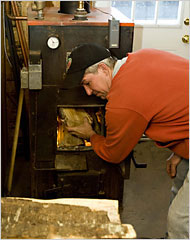With oil prices rising, wood makes a comeback
Updated: 2008-02-19 15:24
http://www.nytimes.com/2008/02/19/us/19woodstove.html?pagewanted=1&_r=1&hp&adxnnlx=1203404684-EhjaC9sqCupoRgLaK3EY7A
NEWPORT, Vt. -- As a child, Brian Cook remembers hurling wood into the big orange boiler his father bought during the oil crisis of the late 1970s, helping feed the fire that provided heat and hot water to his family.
 |
|
Randy Swartz feeding wood to the furnace, which he bought for over $6,000 because of high oil prices. [NYtimes] |
Thirty years later, Mr. Cook dragged the boiler out of his childhood home and hooked it up in the house that he and his wife, Jennifer, own to cut their oil bills.
“I did not want to pay $3,000 to heat this house,” Mr. Cook said in his garage here in Vermont’s heavily wooded Northeast Kingdom. “I see a lot more people burning wood this year.”
After years of steep decline, wood heat is back, with people flocking to dealers to buy new wood stoves, wood boilers and stoves that burn pellets made of wood byproducts. Others like Mr. Cook, to the dismay of environmentalists, are dusting off old wood-burning devices that are less efficient and more polluting.
“There’s a lot of people buying big stoves, planning on tackling oil head-on,” said Roy L’Esperance, owner of the Chimney Sweep in Shelburne, Vt., who has seen sales of wood stoves increase nearly 20 percent this year. “They say, ‘I just got a new house and I’m getting killed with oil bills, and propane is just as bad.’ ”
Nowhere in the nation is wood as beloved as it is here in New England, where winter conjures images of warming up around a potbelly stove. But in the last decade or so, as the price of oil and propane seemed to rise less sharply, devotion to wood stoves waned.
In 1993, 3.1 million homes used wood for heat; the number dropped to 2 million in 2001, according to census data provided by the Energy Information Administration of the Department of Energy.
But now residents like Dina Benoit of Orleans, Vt., are going back.
When Ms. Benoit moved into her home in 1994, it had an old wood stove. Tired of hauling logs through the house and feeding it every few hours, Ms. Benoit switched to a propane heater in 1998. The propane, however, got too expensive, and Ms. Benoit returned to wood. “I didn’t want to become dependent on kerosene or an oil supplier,” said Ms. Benoit, who bought a wood stove and said it cost $600 to heat her house last year. “It’s just so nice to stand next to; it has more of a personality than a regular heater.”
The owners of M and M Forestry and Land Management of Brownington, Vt., say they have been delivering more firewood than ever this year.
“Generally, say they burn a cord of wood a year, this year they are already on their second cord,” one of the owners, Michael Moore, said. “Some people are planning on burning two or three times more wood than they have in the past.”
Statistics from the last survey about the use of wood for heat, conducted in 2006, are not yet public, but the number of households that report using wood as their primary source of heat is expected to jump sharply, said Marie LaRiviere of the Energy Information Administration.
Chris Foster of Maupin’s Stoves-n-Spas in The Dalles, Ore., said sales of wood and pellet stoves were up 65 percent in the last year.
“Sales go up because of the economy,” Mr. Foster said. “If the economy is good, people go to gas. If the economy is sluggish, people go to wood and pellet stoves.”
Jack Murphy of Winchendon, Mass., has long burned wood in his home, but he was tired of buying and splitting the wood, feeding the stove and cleaning the ash. He switched to a pellet stove last year.
“Wood heat is dirty, it’s labor intensive, it messes up your yard and your floors when you carry it in the house,” Mr. Murphy said. “With pellets, I put them in my truck, and I bring my entire energy for the year home in one trip. I have two month’s worth just on my back porch.”
Air pollution is still a major concern, particularly with wood boilers. A 2006 report from the Northeast States for Coordinated Air Use Management, a nonprofit association of Northeast air quality agencies, found that average particulate emissions from one outdoor wood boiler equaled that of 22 wood stoves, 205 oil furnaces or as many as 8,000 natural gas furnaces.
|
|
|
||
|
||
|
|
|
|

